Giselle Clarkson, The Observologist, Walker Books, October 2023, 120 pp., RRP $41.50 (hbk), ISBN 9781776575190
Two of the best things about being a child are noticing things that adults miss and being able to openly express awe. According to this book, an observologist is ‘someone who makes scientific expeditions every day’ and what a perfect description that is since children are always curious and every day can be an adventure. Since the word ‘observology’ is made up, it is easy to assume the book may be fiction but in fact, the information presented in this book is accurate- well mostly.
With 120 pages of interesting facts about tiny creatures, plants and fungi, this book is not only educational but also fun to read as Clarkson delightfully weaves in humour that children would appreciate. Young scientists are taught to look at damp corners, pavements, weedy patches and behind the curtains to find interesting creatures. These four places are how the book is organised into sections. Each section details what can be found in those places. In the damp cover we see slugs, snails, woodlice, centipedes, and millipedes. The pavement covers ants, lichen, worms, eggs, and droppings. A weedy patch tells us about bees, wasps, caterpillars, seeds, leaves, and insects. Finally, behind the curtains exposes us to cockroaches, flies, spiders, moths, and butterflies. My favourite sections were the ‘how to’ sections. Each how to page very cleverly explains a useful skill like how to get a fly to go outside or how to relocate a spider. I especially appreciated how Clarkson indirectly helps young people develop an appreciation for the creatures she describes.
One of the important lessons the book teaches us is that these amazing creatures are all around us and a very easy way to learn is to simply look around us carefully. Also, the book does not just list various creatures randomly but introduces children to scientific ways of organising knowledge. It clearly explains ideas like taxonomy, phenology, and anatomy and why tools, patience and caution are useful. This book will appeal to children 7+ but adults will also learn a lot about invertebrates and the amazing gift that is nature.
Reviewed by H I Cosar






